|
ARBOR Technology Gladius 8
Elegant, rugged and very compact 8-inch Android tablet for IoT (Internet of Things) and numerous other applications
By Conrad H. Blickenstorfer; photography by Carol Cotton
ARBOR Technology, a Taiwan-based ISO-9001 certified embedded and networking manufacturer founded in 1993, announced the Gladius 8 in 2014 as a general-purpose large-screen rugged Android handheld, and also as a building block for emerging IoT applications. RuggedPCReview has now had a chance for extended hands-on with the Gladius 8, and this report presents our review and observations.
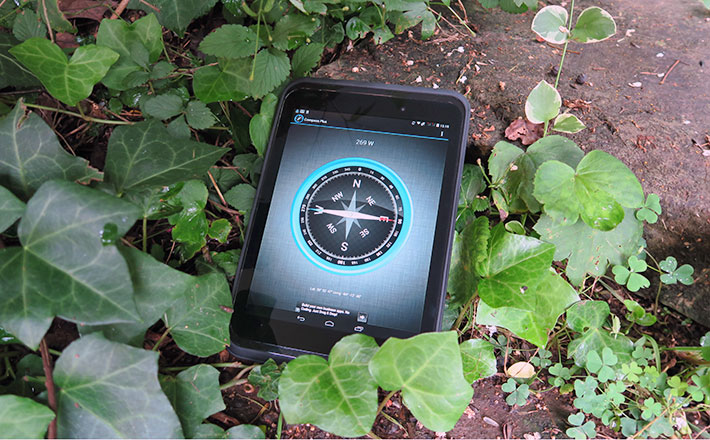
ARBOR calls the Gladius 8 (as well as the smaller Gladius 5) "rugged IoT handheld devices," and that requires a bit of explanation.
Gladius 8 and IoT, the Internet of Things
IoT stands for "Internet of Things" and describes a paradigm where the current internet communication between people or people with machines is extended to "things" communicating as well.  "Things" refers to anything — such as homes, doors, wash machines, cars, subsystems, etc. — that, via sensors, can collect data and pass that data on for processing and action. The IoT infrastructure consists of four layers, those being "Things" refers to anything — such as homes, doors, wash machines, cars, subsystems, etc. — that, via sensors, can collect data and pass that data on for processing and action. The IoT infrastructure consists of four layers, those being
- a) sensors devices,
- b) IoT gateways that share and filter data,
- c) intelligent systems and networks that analyze and manage data,
- d) the cloud with IoT systems analysis and instant feedback, resulting in increased efficiency and reduced costs.
Why is this a big thing? Because experts estimate some 50 billion IoT devices and many trillions of US dollars in increased revenue and reduced cost within the next ten years. And where does the Gladius 8 fit in as a "handheld IoT device?" Both as a mobile sensor device and as an IoT gateway.
As a sensor device, the Gladius 8 uses its various data sensing and collection systems. Those include, on the data sensing side, an ambient light sensor, an accelerometer, a 3-axis digital gyroscope, a barometer, and a digital compass. On the data collection side, the Gladius 8 employs an RFID/NFC reader (peer-to-peer, tag reader/writer, and card emulation modes are available), an industrial-grade 1D/2D imager, as well as an 12.6mp auto-focus documentation camera (in addition to a 2mp frontal vidcam).
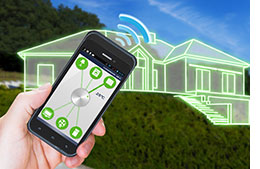 As a IoT gateway device, the Gladius 8 can aggregate its polled and collected data, filter it, do desired local processing, and then pass it on to higher level gateways and networks either via Bluetooth, WiFi or mobile broadband. Once the higher level intelligent systems and/or cloud-based big data and IoT apps have done their processing, the Gladius 8 may then receive real-time feedback for human or machine action. As a IoT gateway device, the Gladius 8 can aggregate its polled and collected data, filter it, do desired local processing, and then pass it on to higher level gateways and networks either via Bluetooth, WiFi or mobile broadband. Once the higher level intelligent systems and/or cloud-based big data and IoT apps have done their processing, the Gladius 8 may then receive real-time feedback for human or machine action.
In order to reliably fill its role as both a mobile sensor and gateway device, the Gladius must be tough enough to hold up to whatever conditions it may encounter in the field. To that end, the device carries IP65 sealing where the "6" stands for it being completely dustproof, and the "5" for the ability to handle low-pressure water jets from all directions. The Gladius can also handle 4-foot drops and operating temperatures between 14 and 122 degrees Fahrenheit. ARBOR claims additional MIL-STD-810G testing, but we haven't seen a complete list yet. The display is protected by Corning Gorilla Glass 3.
Compact consumer tablet size, but much tougher
How big should an IoT handheld be? That depends entirely on the application. While the smaller Gladius 5 looks like a modern smartphone and is the form factor of choice when space is at an absolute premium, the Gladius 8 is more in the iPad mini 3 category. Both are handhelds, but sizewise the Gladius 5 is in the smartphone class whereas the Gladius 8 is a small tablet.
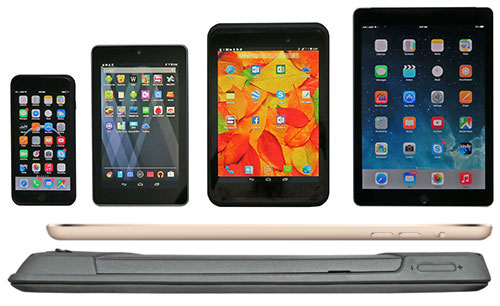 The picture to the right shows where the Gladius 8 fits in terms of size. The lineup shows — from left to right and in scale — Apple's iPhone 6 Plus, the Google Nexus 7, the ARBOR Gladius 8 IoT device, and finally the Apple iPad Air 2. The picture to the right shows where the Gladius 8 fits in terms of size. The lineup shows — from left to right and in scale — Apple's iPhone 6 Plus, the Google Nexus 7, the ARBOR Gladius 8 IoT device, and finally the Apple iPad Air 2.
The Gladius 8 measures 8.6 x 5.7 inches, versus the iPad mini 3's 7.9 x 5.3. Its 8.75 inch diagonal screen size is virtually same as that of the iPad mini 3 (7.9 inches), and with its 4:3 aspect ratio display it is visually almost dwarfing 7-inch tablets that mostly come with narrow aspect ratio screens.
Screen size, though, is only one part of the overall package. As a ruggedized device, the Gladius 8 is 0.78 inches thick, and weighs 1.35 pounds. That's quite a bit thicker and heavier than today's consumer tablets. The iPad mini 3 is sliver-thin at 3/10th of an inch and weighs barely more than half as much as the Gladius 8. The picture above shows how the Gladius 8 compares in thickness to the Apple iPad mini 3.
So while the Gladius 8 looks just like a compact consumer tablet from the front, it's in fact a completely different device, one that's much tougher and offers much more functionality. And while some consumer phone makers now offer versions of their phones that look largely the same as their standard issue models but are better able to withstand abuse and the elements, there aren't (m)any weather-protected compact consumer tablets, and even the few more durable devices are still far less rigid and durable than the Gladius 8.
IoT device technology
Customers interested in a rugged compact tablet such as the Gladius 8 likely intend on using it in a variety of potential capacities, ranging from general-purpose rugged tablet computer, to dedicated IoT edge device, to data capture tool, to simply a super-size version of a modern smartphone. What sort of specs and technologies did ARBOR provide to help the Gladius 8 address all these requirements?
 Powering everything under the hood of the Gladius 8 is, just like in the smaller Gladius 5, a ARM Cortex A7 processor from MediaTek. However, whereas the Gladius 5 uses the 1.0GHz MTK6589 designed for smartphones, the Gladius 8 is based on the tablet-oriented MTK8382 running at a quicker 1.3GHz clock speed. Both are quad-core designs built on contemporary 28nm process technology, but whereas the MTK6589 uses a PowerVR SGX544 graphics processor for parallel graphics acceleration, the MTK8382 hands that duty to an ARM Mali GPU. Powering everything under the hood of the Gladius 8 is, just like in the smaller Gladius 5, a ARM Cortex A7 processor from MediaTek. However, whereas the Gladius 5 uses the 1.0GHz MTK6589 designed for smartphones, the Gladius 8 is based on the tablet-oriented MTK8382 running at a quicker 1.3GHz clock speed. Both are quad-core designs built on contemporary 28nm process technology, but whereas the MTK6589 uses a PowerVR SGX544 graphics processor for parallel graphics acceleration, the MTK8382 hands that duty to an ARM Mali GPU.
There's a gigabyte of RAM and 8GB of Flash for storage. While 8GB doesn't look like much compared to the 16/64/128GB available in current iPads, it's more than adequate if the device can use expansion cards. So for the Gladius 8 it's the 8GB and what is in its user-accessible micro SDHC card slot accessible from the right side of the tablet.
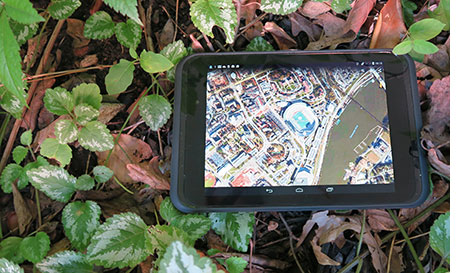 There is an 12.6mp documentation autofocus camera with LED flash on the backside. Customers may also opt for an additional 2mp vidcam in the front, but it's either that camera or an integrated scanner but not both. As for the documentation camera's impressive imager size, the megapixel count is being pushed by some consumer smartphone and tablet manufacturers to differentiate themselves, and we certainly welcome that trend. Apple, though, stayed with 8mp in its iPad Air 2 and just 5mp in the iPad mini 3, so ARBOR is ahead of the game compared to most. There is an 12.6mp documentation autofocus camera with LED flash on the backside. Customers may also opt for an additional 2mp vidcam in the front, but it's either that camera or an integrated scanner but not both. As for the documentation camera's impressive imager size, the megapixel count is being pushed by some consumer smartphone and tablet manufacturers to differentiate themselves, and we certainly welcome that trend. Apple, though, stayed with 8mp in its iPad Air 2 and just 5mp in the iPad mini 3, so ARBOR is ahead of the game compared to most.
The Gladius 8 has a user-accessible and easily removable 22.9 watt-hour Li-Ion battery. That's just a tad less capacity than the iPad mini 3's 23.8 watt-hour, and ARBOR's estimate of "up to 10 hours" of battery life between charges is the same as Apple claims. Charging is via a standard micro-USB port. Wireless charging is available via optional docks (see Qi wiki). Very cool.
Despite Apple's use of it in its small iPad, 8-inch displays with the wide 4:3 aspect ratio are relatively rare in tablets. Most small tablets have been using 16:9 aspect ratio 7-inch screens, with large-size smartphones now increasingly eating into that market. The 4:3 8-inch form factor does offer substantially more display real estate than 16:9 7-inch screens, and for that reason alone many users prefer the larger format for more demanding types of work. That the Gladius 8 uses the smartphone-pioneered projected capacitive ("procap") multi-touch technology rather than a resistive digitizer is pretty much a given, considering that procap is clearly the popular choice these days, and also that Android was designed for it.
All modern smartphones and tablets have sensors, and their presence is especially important in a device that's also designed for IoT duty. As a result, ARBOR equipped the Gladius 8 with a proximity sensor, a 3-axis accelerometer, a 3-axis magnetic field, a barometer, and an ambient light sensor to adjust backlight intensity.
Wired connectivity is via micro-USB 2.0. For wireless connectivity there is integrated Class 2 Bluetooth 4.0LE + EDR, 802.11b/g/n WiFi, NFC, both A-GPS and dedicated GPS, and mobile broadband of the WCDMA UMTS variety.
The image below shows the Gladius 8 from the front and from all four sides. It's an elegant design that combines the all-black glossy look of a modern consumer tablet with the protective rubber-cladding, meticulous sealing, and space for industrial grade expansion like a vertical market device.
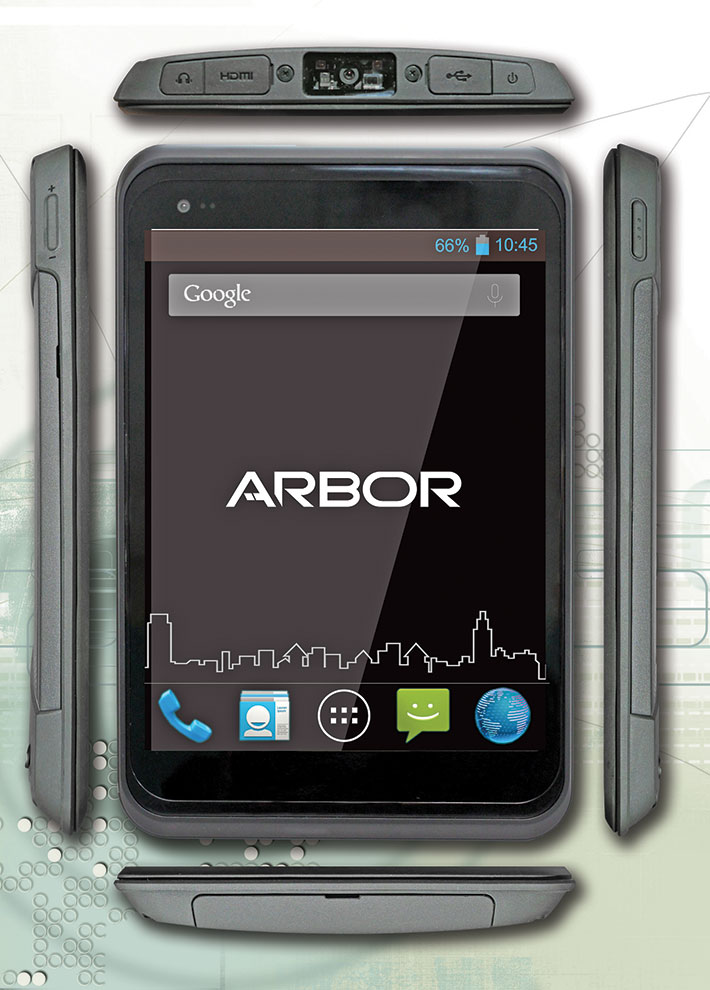
Going around the Gladius 8 reveals a number of controls but not much in terms of ports. This is a well-sealed device, and that means the fewer openings that must be protected against immersion the better.
The left side has a programmable button that can be used to trigger the scanner. On the right side are a volume up/down rocker and, underneath a clip-on cover, the tablet's protected SIM and MicroSD card slots. On top are, beneath protective hinged rubber plugs and flanking the industrial-grade 1D/2D imager window, the unit's earphone jack and micro-HDMI port on one side and its micro-USB port and power button on the other. The bottom does not contain any controls or ports, but provides access to the tablet's battery.
The front of the Gladius 8 is dominated by the large display whose surface glass extends well beyond the perimeter of the LCD, a characteristic common to virtually all capacitive touch devices, so that fingers do not bump into a border during touch. The protective rubber cladding of the Gladius 8 does make for a protruding border around the perimeter of the device, but it's far enough away from the extent of the LCD to not get in the way, and it only sticks up by roughly a millimeter.
Beneath the display are three Android controls (Menu, Home, Back), implemented here as capacitive touch areas with icons outlined in white and illuminated from the inside when the Gladius is in use. That's a bit different from the currently standard trio of Android buttons, those being Multitask, Home, and Back. The "Menu" Android button officially vanished with version 4.0, but apparently ARBOR considered "Menu" more important than "Multitask."
What's inside the Gladius 8?
When it comes to design and construction, consumer tablets are facing two big problems these days. First, there's only so much design you can do on a product that primarily consists of a large rectangular piece of glass. Second, since consumer tablets must be fashionably thin, much of the effort inside goes into miniaturizing components.
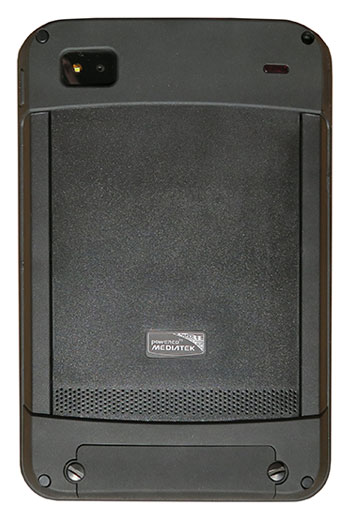
Designers of industrial tablets have a bit more design freedom as those remain very much tools for the job. Compact size and low weight are still important, but they usually aren't deal breakers. The Gladius 8 is a good example of that. At first sight it looks just like another sleek consumer tablet. But look closer and it quickly becomes obvious that it's an entirely different kind of product. Let's find out how different.
The picture to the right shows the backside of the Gladius 8. On the upper left is the camera and flash window, on the upper right a red plastic lens for use with optional/custom IR port. The top and bottom areas have a rubberized feel, the center area doesn't. The perforated band near the bottom looks like just a design feature, but it actually includes the grilles for the tablet's stereo speakers.
The vertical bars to the left and right of the center area are actually snap-on plastic pieces. On the left side they cover the GPS, WiFi, Bluetooth, and mobile broadband antennae. On the right side the SIM card and microSD card slots. Like the Gladius 5, the Gladius 8 has dual SIM card slots, allowing for two separate mobile connections/accounts.
The tablet's flat, rectangular 3.8V 6,200mAH (23.6 watt-hour) Li-Ion battery is replaceable and user-accessible. To get to it, there's first a small cover with two screws at the bottom of the unit to remove, and then there's prying out another piece of plastic that seals the battery compartment. The battery can then be shaken out. It's not the simplest or most intuitive arrangement, but what matters is that the battery is replaceable.
As stated, while from the front the Gladius 8 looks like your standard consumer tablet, it is a significantly more substantial unit. Opening it requires undoing a number of small Philips screws, then a good degree of careful prying apart of the two halves. There are no wires or ribbon cables between the two halves. Instead, connections are made via springloaded pins (for the NFC and WPC antennae).
The two halves are sealed against each other with an intricate tongue-and-groove design, where the groove additionally contains a very thin replaceable O-ring. The O-ring has eight little tabs so that it can be properly placed.
The pictures below shows what it looks like inside the Gladius 8:
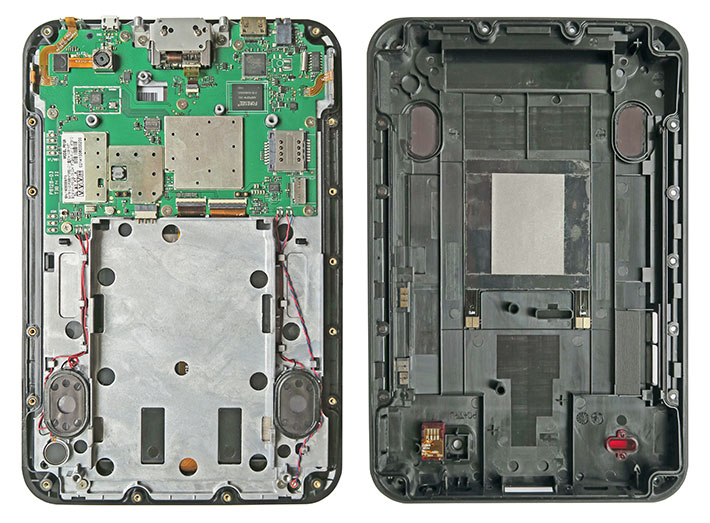
As for the material of the two halves, in general, the "plastic" used in rugged mobile computing devices is PC+ABS, which is a polycarbonate and ABS (Acrylonitrile Butadiene Styrene) alloy that combines the strength of polycarbonates with the high abuse resistance of ABS, but at a lower cost. ARBOR, on the other hand, chose PC+TPU, an alloy of polycarbonate and TPU (thermoplastic polyurethane elastomer), with TPU excelling at abrasion and wear resistance, high tensile and tear strengths, as well as having rubberlike elasticity. The Gladius 8's "plastic" parts do indeed have those properties, combining toughness, flexibility, and a rubber-feeling exterior for impact protection and a good grip.
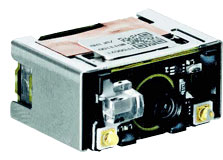 Stability and rigidity is provided by a magnesium chassis that on one side has a corral for the battery and next to it the motherboard, and on the other side the display and digitizer. The entire system is nicely integrated, with most electronic components located underneath metal shielding. Stability and rigidity is provided by a magnesium chassis that on one side has a corral for the battery and next to it the motherboard, and on the other side the display and digitizer. The entire system is nicely integrated, with most electronic components located underneath metal shielding.
The scanner in our eval unit was a Opticon MDI-3100, a speedy fixed-focus 2D CMOS imager with a maximum decode speed of 60 frames per second (see MDI-3100 page here). It uses LEDs for barcode targeting so there is no need for lasers and their associated regulations.
The image compilations below shows some of the interesting details of the ARBOR Gladius 8. On the left you can see a close-up of the intricate camera module, in the center a close-up of the SIM and microSD card slots, and on the right a look at the thin rubber O-ring sitting in its groove. Note the small removal tab that makes it easy to handle and place the ever-important seal.

Below on the left is a look at the two friction cover plugs for the SIM and microSD slots. They are not hinged and thus somewhat easy to lose. In the center one of the two remarkably powerful speakers, and on the right you can see the imager firmly secured onto the motherboard.

The insides of the Gladius 8 leave a very good impression. This is a well conceived and executed design that's very stable. The one concern we have is the number of small snap-on and clip-on parts that can get damaged or lost. Particularly impressive is the elegant, functional magnesium frame with its custom-designed main and subsidiary boards that together form a compact, logical and very clean solution.
Display — 7.85-inch and procap multi-touch
The Gladius 8's 7.85-inch display is somewhere between a large smartphone and a full-size tablet. While the Gladius can be used as an internet phone via Skype or a dedicated internet voice service, this is very clearly a tablet and not a large phone.
The screen's 1024 x 768 pixel XGA resolution is perhaps a bit puzzling in an era where much smaller smartphones routinely offer 1920 x 1080 pixel displays, and some even full 4k. Even the smaller Gladius 5 offers more pixels (1280 x 720) on its 5.5 inch screen. So why did ARBOR use comparatively low 1024 x 768 resolution in the Gladius 8, the same as has been used in rugged tablets for a decade or more?
To put things in perspective, 1024 x 768 is the same resolution of the original iPad and the iPad 2. Tens of millions of those were sold, and I can't recall many complaints about the Pad's screen resolution, even though its display measured 9.7 inches versus the Gladius 8's 7.85. We're talking about 163 dpi (dots per inch) here, which is the same as that of the original iPhone and the initial iPad mini. It's also better than any non-retina MacBook Pro and Air laptops, and better than the 10.1-inch Samsung Galaxy Tab. And it's vastly sharper than the iMac27 screen that I am writing this review on.
Would it be nice to have full 1080p? It would, but it's really not necessary for the work the Gladius 8 is intended for. For now, it's really more of a matter of smartphone resolutions getting insanely high in a heated one-upmanship between manufacturers. Further, dpi is not all that matters. Viewing angle is often as important or more. And here the Gladius 8 shines with a perfect viewing angle from all directions, with no color shifts whatsoever.
The picture below shows the Gladius 8 on a cloudy Tennessee morning with the brightness control set to automatic. The unretourched image clearly shows how bright and vibrant the display is.
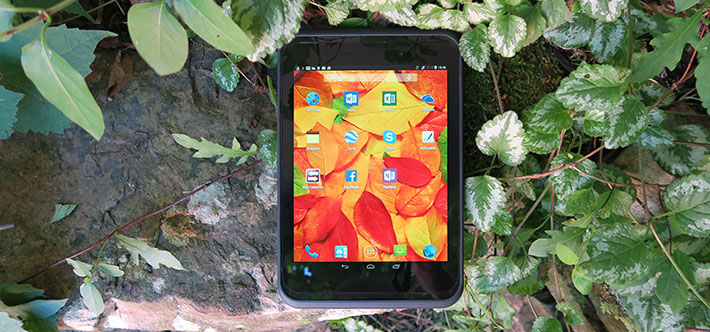
Capacitive multi-touch works as everyone expects from a handheld these days — quickly and effortlessly. The touch controller ARBOR used is more sensitive than that in most earlier capacitive touch devices. That means it can work when wearing certain types of thin gloves. The device doesn't come with a stylus and ARBOR doesn't offer an optional capacitive pen. Any 3rd party capacitive pen will work, though those generic pens with their broad tips don't offer much more accuracy than the tip of a finger. It's not that important anyway as Android was specifically developed for capacitive multi-touch with a finger.
Android versus Windows
Our review Gladius 8 ran Android 4.4.2, and unlike a number of recently introduced industrial handhelds, there's no corresponding Windows based version. Why?
For the Gladius 5, that question was easily answered. It was because the vast majority of non-Apple smartphones run Android, and even compared to Apple, Android has a commanding market share. As a result, many providers of ruggedized handhelds now offer both Microsoft and Android based versions of their handhelds or are leaning towards Android.
On the tablet side, things are a bit different. While Apple and Android also hold a commanding marketshare, for one reason or another many rugged and vertical market tablets are Windows-based. It may be that enterprise Microsoft shops wish to leverage their Windows investment to tablets rather than supporting another software platform, or it may be that complex industry-specific software is only available on Windows. Almost all providers of rugged tablet hardware have realized that, and are offering both Windows and Android tablets.
ARBOR itself is no different. The company's approach has been to offer whatever OS platform seems suited best for a certain device class and application; they offer both Android and Windows in different models of its growing rugged tablet lineup. For an example of ARBOR's Microsoft Windows-based tablet offerings, see our comprehensive review of the ARBOR Gladius G0975 rugged Tablet PC.
Given Android's massive market share, it's quite obvious that Android-based work devices will have instant appeal and familiarity to those who are already using Android smartphones and/or tablets at home or at work. Though often customized by voice and data service providers, the basic workings of the Android interface are very widely known by now, and a very large number of apps are available for download. Android software development and expertise is commonly available, and making Android devices available on the job can save training as well as deployment costs.
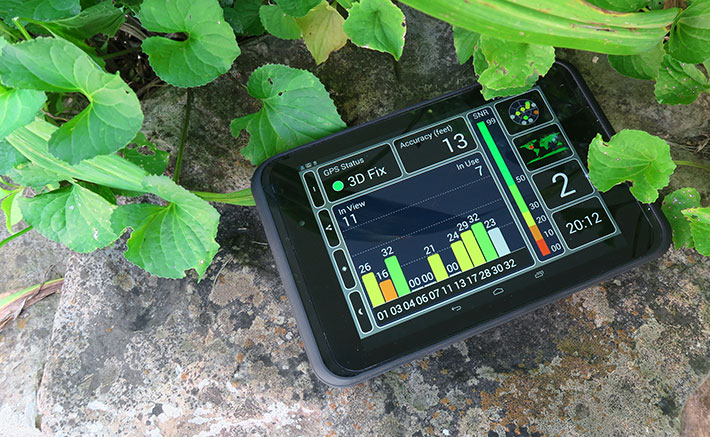
Additional Android contemplations
The total number of available apps for a handheld software platform has become a crucially important marketing issue, as is how easily users can download apps. Apple has its slick and massive App Store. Android offers the official 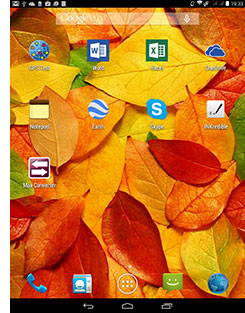 Google Play store, as well as third party alternates such as the Amazon Appstore for Android, Slide ME, and several others. Google Play store, as well as third party alternates such as the Amazon Appstore for Android, Slide ME, and several others.
There is, however, an important difference between consumer and industrial markets here. Whereas a vast number of easily accessible apps is a big plus for consumers, many industrial and enterprise deployers do not want their workforce download (and distracted by) apps into devices used for work. What are the answers to this potential problem?
One approach is to use Android AOSP, which stands for Android Open Source Project, and is an open-source software stack and project, led by Google itself, but without the ability to use the Google Play store and some of the major Google apps. Android AOSP, however, still has access to alternate app stores.
Another possibility is using something like 42Gears.com's SureLock. SureLock replaces the Android desktop and allows control of applications that are available to users. It can even be configured to run in "kiosk mode" with just a single application that is always active. This way, systems integrators or IT personnel can configure units for specific use and applications, eliminating the temptation that comes with a full load of consumer apps.
The Gladius 8 sample unit ARBOR sent us for evaluation came not only with a basic selection of useful apps, but also with the official Google Play store. Google does make it possible to customize the look and feel of an Android device, and organizations can publish their own Android apps or officially sanctioned apps privately to a dedicated company-owned channel on Google Play.
A wealth of applications
Among the main attractions of Android tablets is the vast number of apps that area readily available for download. While highly specialized applications may require custom software development, chances are that a free or inexpensive app can be found for almost everything else. Below are a number of screen shots of apps that were installed on our review Gladius 8 tablet, and that we downloaded from Google Play.
The first series of three screen snaps shows the main Android app screen on the left, a search screen from the Google Play store showing transportation-related apps in the center, and on the right an example screen from a shipping app. One of Android's strong points is that there are tens of thousands of potentially very useful apps.
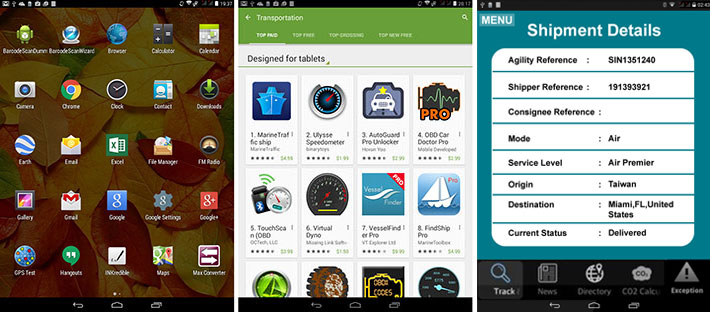
There are several office suites available for Android, but many enterprise and business users will want Microsoft Office. An Office 365 client is available for Android, and since November 2014 it no longer requires a paid Office 365 subscription to edit documents and store them in the cloud. Office Mobile is not a complete implementation of the full Office 365, but it works just fine.

Below are examples of Microsoft Word (left) and Microsoft Excel (center) files we tried on the Gladius 8. We encountered no problems. Most users should be able to load and work on even complex files when using a Gladius 8 on the road. On the right a bit of doodling on Microsoft OneNote.
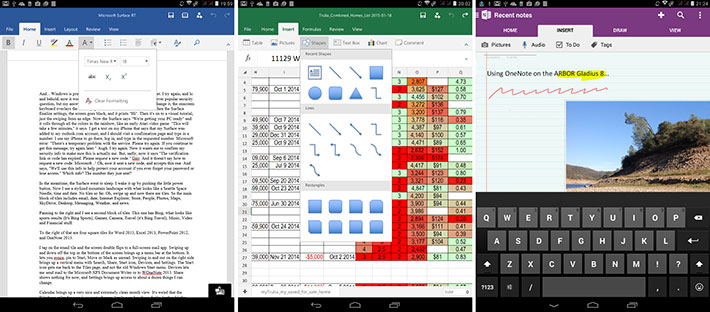
Next on the list of downloads might be the ever-amazing Google Earth for mapping, satellite imagery, mapping with traffic information, or Street View. The large size and full XGA resolution of the Gladius 8 display makes mapping and GIS a natural for the device, and there's a large number of GPS apps that show satellite and location data (we used GPS Test).
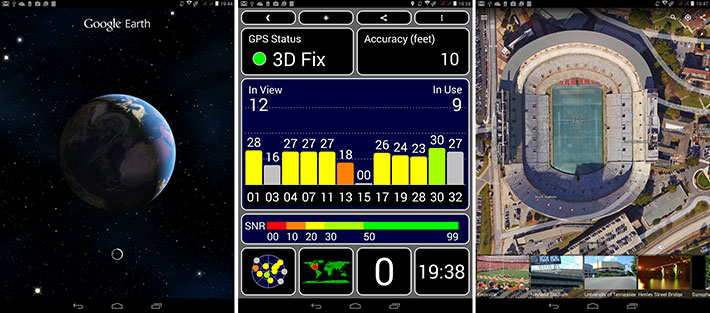
Web browsing can be somewhat frustrating on small handhelds, but the Gladius 8 screen is large enough, most of time web pages can load in their full versions (as opposed to the often unsatisfying "mobile" versions), and there's enough resolution, and processing power for a productive browsing experience. The screen snap on the right shows a file listing from Microsoft OneDrive, the cloud-based storage system we wouldn't leave home without.
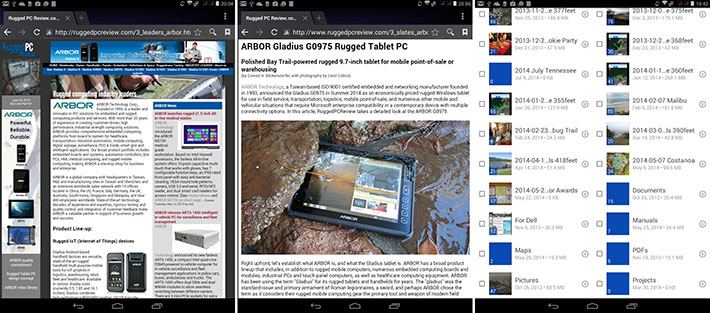
Out there in the field there's often a need to take a couple of notes and perhaps do a quick sketch. And a toolbox of utilities comes in handy. As examples, we downloaded the electronic equivalent of a little yellow notepad (left), the INKredible calligraphy app, and a unit converter (we used Max Converter). Thousands of such utilities are available from the Google Play store.
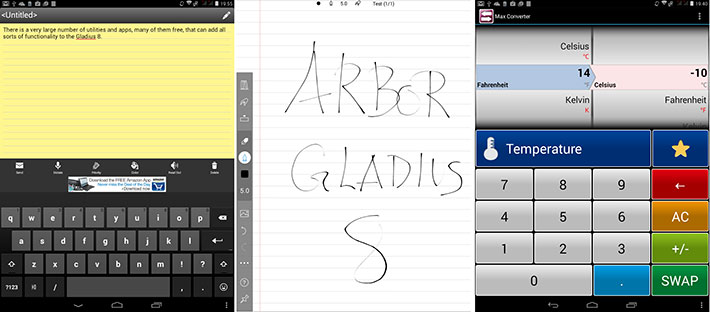
Below, as another example of a dedicated app that can be quite useful, are screen snaps of Mobile Developed's OBD Car Doctor Pro that can read dozens of parameters from a vehicular engine control unit computer in real time, diagnose problems, clear error codes, etc. All for $2.99 plus an OBD-II Bluetooth adapter (inexpensively available on eBay).

The above serves as just a small sample of the numerous everyday informational and productivity tasks the Gladius 8 tablet can be used for. Many thousands of other apps are available, on top of whatever custom or professional software users may wish to install.
Very good cameras
The ARBOR Gladius 8 has both a front and a rear camera, as one would expect from a modern tablet. The front one is for video calls and such, and offers 2 megapixel resolution. The rear one is for picture taking and documentation. The specs claimed an 16 megapixel imager, but the pictures we took came out in 4,096 x 3,072 pixel resolution, which is 12 megapixel. Camera settings allow selecting resolutions from just QVGA all the way up to 12mp. Both cameras can be used for stills as well as for video.
By and large, with few exceptions our experience with cameras integrated into rugged vertical market handhelds and tablets has been underwhelming over the years, with even the best ones lagging behind what's available in dedicated point & shoots and consumer smartphones. 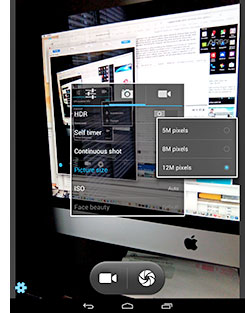 This is starting to change now, possibly through the very wide distribution of Android-based smartphones equipped with good cameras. Whatever the reason, the rear-facing documentation camera of the Gladius 8 is quite good. The test pictures we took with the device were absolutely good enough for most documentation tasks.
This is starting to change now, possibly through the very wide distribution of Android-based smartphones equipped with good cameras. Whatever the reason, the rear-facing documentation camera of the Gladius 8 is quite good. The test pictures we took with the device were absolutely good enough for most documentation tasks.
The screen snap to the right shows some of the camera settings screens, and what it looks like in picture-taking mode.
The user interface is quite elaborate, with 14 scene settings, 7 color effects, 8 white balance settings, +/-3EV exposure control, face detection, 2/10 second self timer, 40 or 99 continuous shots, picture sizes from VGA all the way up to 8mp, ISO settings from 100 to 1600 and auto, HDR capturing, panorama shooting, and more. When using the front camera, the focus can follow your face automatically, which comes in handy if you move around a lot.
Users can edit pictures right on the Gladius 8. There is a wealth of functions available, including color effects, frames, cropping, straightening, mirroring, numerous filters, and even such advanced operations as sharpening, hue, vibrance and curves. The camera app also supports social media. You can directly send images to Picasa, Messaging, email, Skype, OneDrive or whatever other social media apps you have on the device. And images can also be converted to PDF.
In video mode, there is a special meeting recording setting for audio recording, and the microphone can be turned on and off. There is also time lapse video with a picture taken shot every one to 10 seconds, and users can set video quality. We got video to record in resolutions ranging from 640 x 480 VGA all the way up to full 1080p 1920 x 1080. Video quality was quite good, frame rates as well, and the LED illuminator was strong enough to be of real life use.
Having all those many settings and features available will be important to some users, but what's most impressive about the Gladius camera apart is its speed and quality. It is well suitable to document jobs both in stills and in video.
The pictures below were shot with the ARBOR Gladius 8 in 12mp mode. Click on the image to bring up a full-size version.
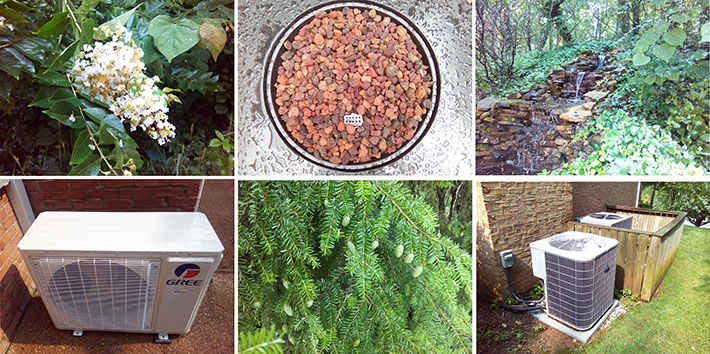
The Gladius 8 documentation camera is capable of taking much better pictures than we generally see from industrial tablets. There is very good sharpness and image detail, and little of the massive compression that often renders pictures from such integrated cameras useless.
Video is also significantly better than what we've come to expect from cameras integrated into rugged devices. Frame rate and focussing are quick and the camera doesn't fall behind. The maximum 1920 x 1080 recording format is very useful, and, of course, pretty much expected by today's users.
Note that the camera applications that come with mobile operating systems are often replaced with third party applications optimized for certain tasks, or developers and systems integrators include camera and video functionality directly into custom applications.
In summary, the still image and video functions of the Gladius 8 are entirely good enough for virtually any documentation jobs.
Vehicle and desktop docks with wireless charging
Unlike consumer tablets where customers may want/need nothing more than a protective case, enterprise market device such as the Gladius 8 need mounting and docking options.

For that, ARBOR offers both an in-vehicle docking mount as well as a desktop cradle. Both use the same snap-in tablet holder that then locks on to either a suction cup vehicle mount, or a rotating desk stand. Neither is a port replicator. The vehicle dock comes with a power plug charger, the desktop stand with a standard power brick charger.
Both optional docks provide Qi-based wireless charging technology, which means there is no power cable to be inserted or removed from the Gladius tablet. The docks also have standard VESA 4 x 75 mm hole patterns and have therefore access to the whole catalog of RAM Mount mounting hardware (see examples of RAM VESA mount options).
Tough enough for rough jobs out there
Rugged tablets used to look like tanks, and weigh nearly as much. Not anymore. Despite its elegant consumer tablet appearance, the Gladius 8's environmental specs are decidedly rugged, and an examination of its internal design and structure revealed that the tablet can back it up. This is a compact tablet that's much tougher than it looks.
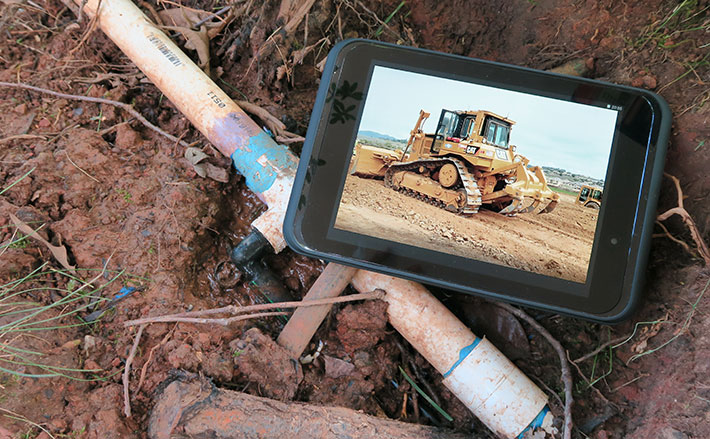
To protect itself from the elements, the Gladius 8 carries IP65 sealing where the "6" means it's totally dustproof, and the "5" that it is also sealed against, according to the IP classification system chart, low pressure water jets from all directions. That's far better sealing that standard consumer tablets have. Consumer smartphones, though, are now available in IP67- and even IP68-sealed versions, raising expectations. It's more difficult to seal larger devices than smaller ones, but the day can't be far when IP67 is considered must-have. It's not totally necessary, but knowing that one's tool could survive an inadvertent drop into a puddle or even shallow stream would offer additional peace of mind.
The Gladius 8 can also handle drops from four feet. That's a foot less than the smaller Gladius 5 can handle but, again, it's more difficult to cushion larger and heavier devices. Tablets, of course, are usually dropped when operating them in a standing position, and such falls are not more than about four feet.
The stated operating temperature range of 14 to 122 degrees Fahrenheit (-10 to 50 degrees Celsius) is wide enough to allow the device to be used almost anywhere.
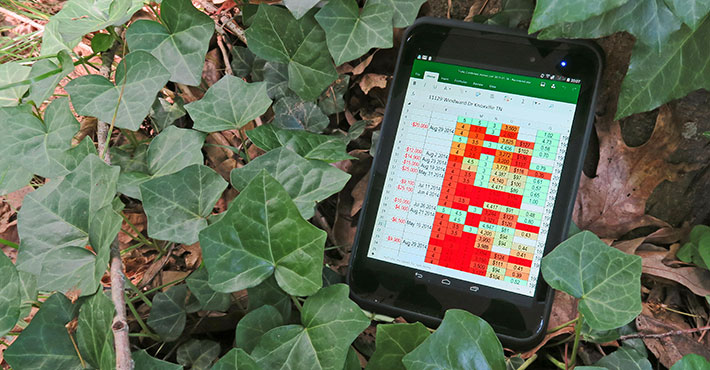
The display uses Corning Gorilla Glass 3 that provides even more protection against breakage and scratching than the first two generations. That's especially important in large-screen handhelds such as the Gladius 8.
The impressive strength provided by the internal magnesium frame suggests a high degree of toughness and ability to withstand accidents and abuse. ARBOR's literature mentions MIL-STD-810G certification, but does not say which MIL-STD-810G or similar tests, specifically, have been performed. Vibration, for example, can be a big issue if a device rattles around in a vehicle or if it's mounted on something that vibrates a lot. Users may also want to know its ability to handle tumbles, altitude, shock, and other punishment that may well be an issue in some of the more demanding IoT or even mPOS applications..
We're quite confident that the ARBOR Gladius 8 will hold up well in the field and under tough conditions. Its structure and design are first class, its sealing is exemplary, and Gorilla Glass protects the display, but we'd still like to see more official test results. And it'd be nice to see fewer loose plugs and clip-on pieces.
Summary: ARBOR Gladius 8 — a compact, rugged Android tablet for IoT and numerous other professional applications
With the Gladius 5 and Gladius 8, ARBOR Technologies offers two elegant, rugged Android-based handheld computing devices for IoT (Internet of Things) and numerous other applications. While the Gladius 5 uses the smartphone form factor, the larger Gladius 8 is a compact tablet that's a bit larger than an Apple iPad mini, but a lot tougher and more durable.
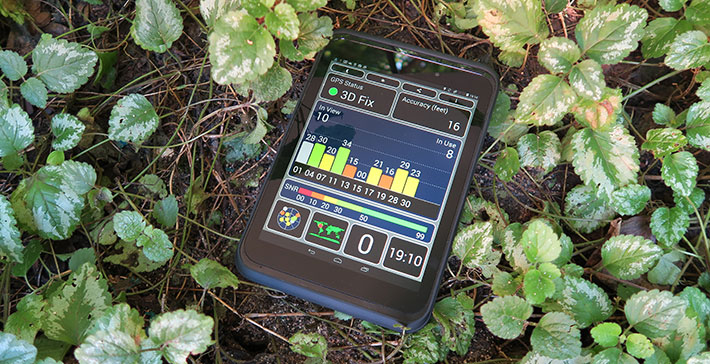
The Gladius 8 can be used for a vast variety of applications. Its scanning and NFC capabilities make it a powerful data collection and mobile point of sale device. Its inherent ruggedness make it suitable for any number of field service, transportation and public safety deployments. It can easily be mounted in vehicles with its special V-Dock that even includes wireless charging. And its elegant looks and full modern tablet capabilities make it perfect for numerous enterprise and business uses.
Sporting a large, bright 7.85-inch capacitive multi-touch display means there's significantly more screen real estate than in any smartphone and also considerably more than in 7-inch tablets. The 1024 x 768 XGA resolution is crips and sharp on this size display, and numerous legacy professional software applications use this format.
The replaceable battery lasts a full shift and more. There's an industrial-grade 2D CMOS imager, a very good 12-megapixel documentation camera. The Gladius 8 survives 4-foot drops, can operate in icy cold and blistering heat, and its IP65 sealing means it doesn't mind dust or rain.
With the Android-powered Gladius 8, ARBOR provides an elegant-but-rugged compact tablet entirely suitable for emerging Internet of Things projects, but also as a technologically advanced multi-purpose handheld computer for numerous warehousing, transportation, healthcare, mPOS and general industrial and enterprise deployments. And for a rugged tablet in this class, its starting price is remarkably affordable.
-- Conrad H. Blickenstorfer, July 2015
ARBOR Technology Gladius 8 Specs:
| Added/changed |
Added 09/2014, full review 07/2015
|
| Type |
Rugged Android IoT handheld
|
| Processor |
1.30GHz Quad-core Cortex A7 MediaTek MTK MT8382
|
| Graphics |
ARM Mali GPU
|
| OS |
Android 4.4
|
| Standard/Max RAM |
1GB/1GB |
| Disk/drive |
8GB onboard, plus microSD card storage |
| Display type |
TFT with anti-reflective coating and Gorilla glass 3 protection |
| Display size/resolution |
7.85-inch/XGA (1024 x 768 pixel) with anti-reflective properties |
| Digitizer |
5-point projected capacitive multi-touch |
| Keyboard/keys |
Onscreen
|
| Navigation |
Touch
|
| Expansion slots |
1 x microSD/SDHC Card (up to 32GB), 2 x SIM card
|
| Housing |
est: PC+TPU polymer over magnesium frame
|
| Size |
8.6 x 5.7 x 0.78 inches (218 x 145 x 20 mm)
|
| Weight |
1.35 lb. (610 grams) with battery
|
| Operating temperature |
14° to 122°F (-10° to 50°C) |
| Ingress protection |
IP65 (totally dustproof, sealed against low pressure water jets from all directions) |
| Humidity |
95% non-condensing |
| Drop |
4-foot drops |
| Vibration |
MIL-STD-810G testing |
| Altitude |
Unknown |
| Tumble |
Unknown |
| ESD |
Unknown |
| Power |
3.7V, 6,200mAh 22.94 watt-hour ("up to 10 hours") |
| Regulatory |
est: FCC, CE, CB, UL, NCC. A-TICK/C-TICK, VCCI, Japan TELEC |
| Camera |
Front: 2.0mp, rear: AF 12mp with LED |
| Scanner |
Est: Optional dedicated Honeywell N4313 1D laser scanner or Honeywell N5600 1D/2D imager |
| Sensors |
Ambient light, 3-axis gyroscope, accelerometer, barometer |
| Communication |
802.11b/g/n, Class 2 Bluetooth 4.0 + EDR, 13.56MHz RFID/NFC, WCDMA UMTS 850/900/1900/2100, GPS, A-GPS |
| Interface |
1 x micro USB 2.0, 1 x Mini HDMI, 1 x 3.5mm headphone |
| Price |
Inquire |
| Spec sheet |
 Gladius 8 brochure (PDF) Gladius 8 brochure (PDF)
|
| Web page |
Gladius 8 web page |
| Contact |
ARBOR Technology Corp.
10F., No.700, Zhongzheng Rd.
Zhonghe Dist., New Taipei City 235
Taiwan, R.O.C.
Tel: 886 2 8226 9396
Fax: 886 2 8226 9398 |
|



